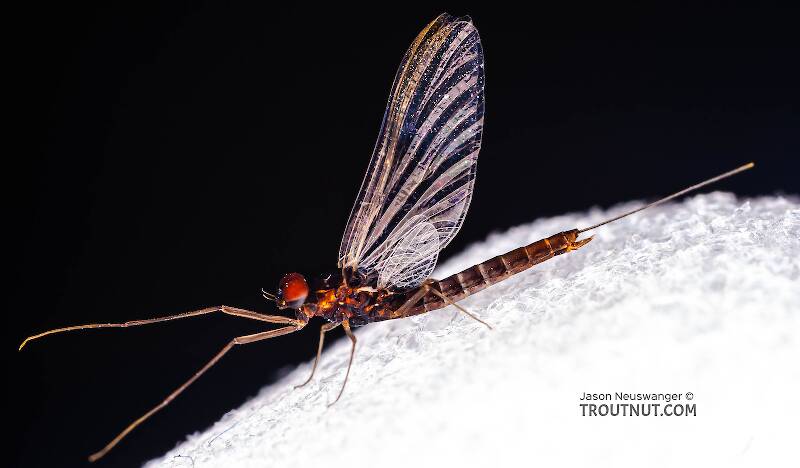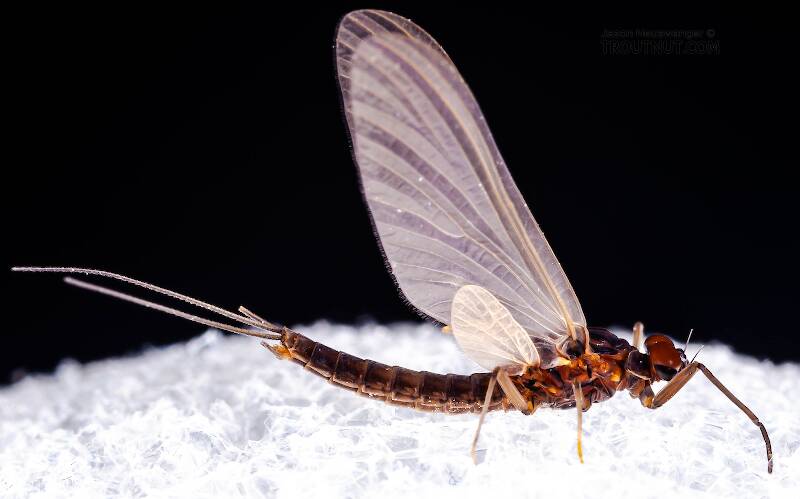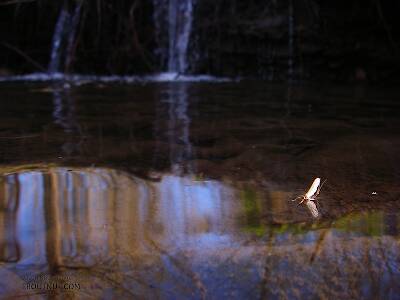
Hex Mayflies
Hexagenia limbata
The famous nocturnal Hex hatch of the Midwest (and a few other lucky locations) stirs to the surface mythically large brown trout that only touch streamers for the rest of the year.


Mayfly Species Neoleptophlebia adoptiva (Blue Quills)
Where & when
The hatch begins in early April in the southern Appalachians. By late April or early May it is in Pennsylvania, and it peaks in the Catskills in early May. By late May it has moved into the Upper Midwest and the Adirondacks, where it may linger through early June. The peak hatching lasts nearly a week in most places.One source, Mayflies of Michigan Trout Streams, says the hatch may last until July 8th, but I have found no other accounts of such late adoptiva hatches.
In 4 records from GBIF, adults of this species have been collected during April (75%) and June (25%).
In 2 records from GBIF, this species has been collected at elevations of 443 and 896 ft.
Species Range
Hatching behavior
Caucci and Nastasi in Hatches II say that trout feed exceptionally well on these nymphs during the hatch, and they recommend fishing nymph imitations (both deep and floating) with an upstream dead-drift. However, the duns should not be ignored, because they may ride the surface for a long time before flying away.The hatch can be strongest on cold, dark, even snowy days.
Nymph biology
Current speed: Medium is best; slow is good; slow microhabitat in fast stretches are okay
Substrate: Gravel, detritus
Physical description
Most physical descriptions on Troutnut are direct or slightly edited quotes from the original scientific sources describing or updating the species, although there may be errors in copying them to this website. Such descriptions aren't always definitive, because species often turn out to be more variable than the original describers observed. In some cases, only a single specimen was described! However, they are useful starting points.
Male Spinner
Wing length: 7-8 mm
This is a blackish species with a brown abdomen that is only a little paler in the middle. Top of head and thorax shining black, only the sutures on the sides paler; dorsum of the first abdominal segment also blackish. Legs brown including the tarsi, paler brown beyond the knees. Wings sub-hyaline with brown veins and darker brown wing roots. Costal cross veins faint and rather numerous; those of the stigmatic region long, sinuate and crowded, but little conjoined. The abdomen is nearly uniform brown, only the base of segments 3-5 showing a suggestion of pale rings; and the apical segments are only a little darker on the dorsum. Forceps yellowish brown; the 2nd joint twice as large as the 3rd. Penes appressed, half as long as the first joint of the forceps. The sperm ducts terminate before the apex between a rounded inner lobe and an outer triangular tooth that is turned sharply laterally; below this the outer margin of the penis is suddenly widened and the basal portion parallel-sided (see fig. 135). Tails uniform pale brown.
Specimens of the Mayfly Species Neoleptophlebia adoptiva
1 Male Dun
1 Male Spinner

1 Streamside Picture of Neoleptophlebia adoptiva Mayflies:
Start a Discussion of Neoleptophlebia adoptiva
References
- Arbona, Fred Jr. 1989. Mayflies, the Angler, and the Trout. Nick Lyons Books.
- Caucci, Al and Nastasi, Bob. 2004. Hatches II. The Lyons Press.
- Knopp, Malcolm and Robert Cormier. 1997. Mayflies: An Angler's Study of Trout Water Ephemeroptera . The Lyons Press.
- Leonard, Justin W. and Fannie A. Leonard. 1962. Mayflies of Michigan Trout Streams. Cranbrook Institute of Science.
- Needham, James G., Jay R. Traver, and Yin-Chi Hsu. 1935. The Biology of Mayflies. Comstock Publishing Company, Inc.
- Schwiebert, Ernest G. 1955. Matching the Hatch. MacMillan Publishing Company.
Mayfly Species Neoleptophlebia adoptiva (Blue Quills)
Species Range
Common Names
Resources
- NatureServe
- Integrated Taxonomic Information System
- Global Biodiversity Information Facility
- Described by McDunnough (1929)



